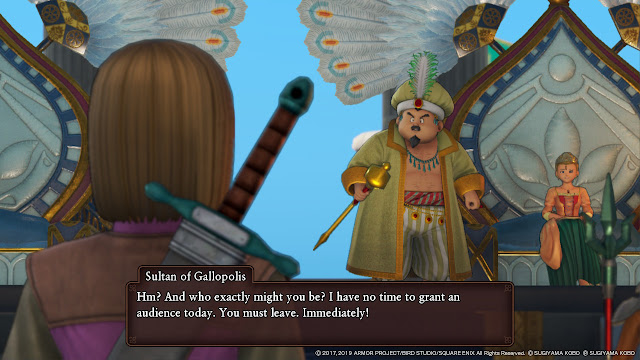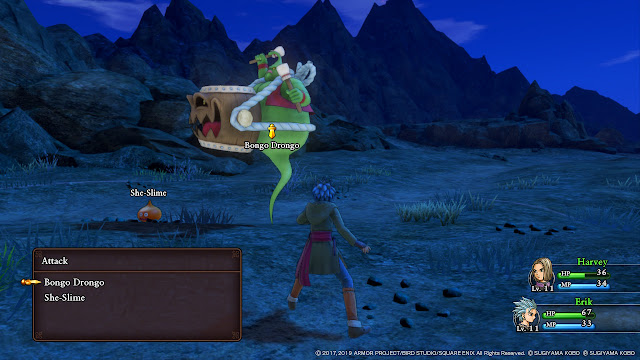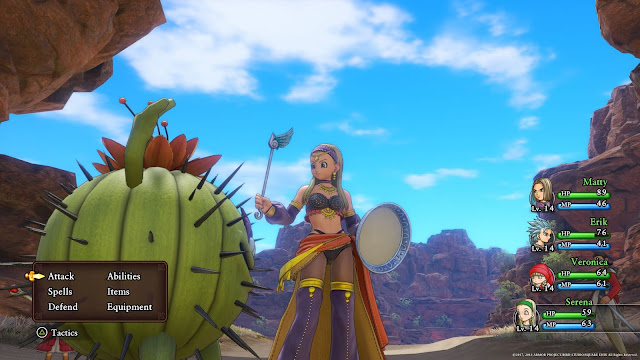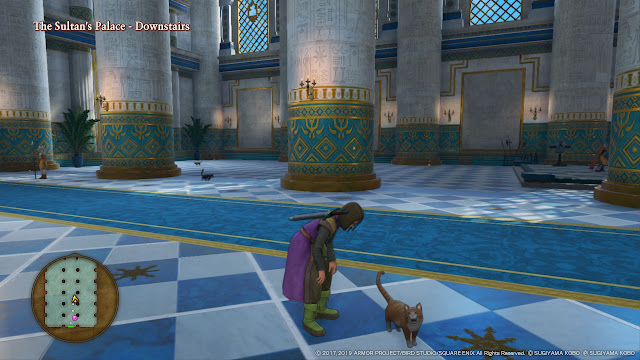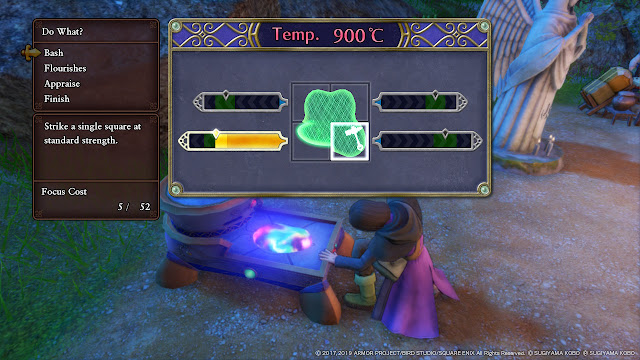Review by Harvard L.
I wish this game had the subtitle, “a Dragon Quest for fans and first timers”, because that’s precisely what Square Enix was going for in this iteration of the long-running JRPG franchise. The base game released on the PS4 two years ago, along with a Japan only 3DS port which contained entirely different graphical assets, and now the two have been combined together in the Switch’s Definitive Editing. This is one of those rare times where I can say the definitive release is for everyone: if you’ve never touched a Dragon Quest game in your life this is still a great point of entry, and if you’ve beaten XI on the PlayStation 4, there’s enough added to the Nintendo Switch edition that it’ll feel like a whole new adventure.
The Switch port mixes in everything good about the PS4 and 3DS versions, with a little bit extra as the cherry on top. From the PS4 versions we get the largely unchanged 3D graphics, as well as the crossbow minigame that sees you seeking out targets in the game’s expansive overworld. From the 3DS version comes 2D mode, where the entire game is lovingly recreated in 16-bit sprites, and there’s also the bonus zone which transports the player back in time to explore historic moments in the Dragon Quest franchise. This game certainly feels like a victory lap of not just Dragon Quest XI but also the entire series – tying together all the hallmarks of the long running JRPG franchise.
But that all hardly means anything if you’re unfamiliar with what Dragon Quest means. The series has been monumentally successful in Japan, (just for scope, Super Mario Bros 3 for the NES moved 250,000 copies on its first two days in Japan, and eight months earlier that same year, Dragon Quest 3 sold one million on its first day) but it has also historically seen paltry support in English speaking regions. Part of that is largely because of the trouble of localising a mountain of Japanese text, and Dragon Quest has never made it easy for translators either since it’s full of humour, wordplay and niche cultural references.
For the new player, Dragon Quest means tradition. It’s about an adventure of a Chosen One across a vast vaguely medieval fantasy landscape, picking up allies, dealing with random encounters and overall making the world a nicer place to live. For those more accustomed to Final Fantasy, which wholly reinvents its worldbuilding, battle system and narrative structure with every new numbered entry, the Dragon Quest games could feel unambitious by comparison. For all the innovation each title has brought to the JRPG genre itself, so many design decisions in XI seem positively archaic, as if the development team were speaking through the controller to tell you, “we’ve just always done it this way”.
That being said, it feels silly to criticise a game for lack of groundbreaking innovation if its franchise laid the groundwork for the entire genre. And for a series that moves as much clout as Dragon Quest, who can blame them for giving the people more of what they want?
Make no mistake, Dragon Quest XI is huge. This is a game which will take you months to see everything – even the main quest itself can clock out at over sixty hours – but it’s the experience of it all which makes it all the more worthwhile. Most of the time I take issue at overly-long games because they pad out and weaken a narrative which did not need that much time. With Dragon Quest however, I think of it in the same vein as Akira Toriyama’s Dragon Ball manga, or maybe even One Piece: it’s about the journey the hero takes, and the places and people they meet along the way. So as long as the journey feels fresh and invigorating, the game could last forever for all I care.
Dragon Quest XI’s locales certainly do not disappoint in this regard either. The overall narrative is largely a forgone conclusion with plot twists you’ll see a mile away. The player is the reincarnation of the Luminary, a being with special heightened powers foretold to cleanse the world of monsters – but the legend has corrupted over time so that the great Empire of the region regards the Luminary as the Darkspawn, and is hellbent on stopping your quest to realise your destiny. I appreciate the narrative for having just the right amount of urgency and no more than that – it’s a framing device to guide the player through a variety of picturesque locations, each with their own distinct style and character.
The game takes place on an expansive overworld where random encounters (at least in the 3D version) can be seen and avoided. Traversing this space takes time, and although it’s not the most riveting of gameplay mechanics, the graphics, world design and sheer scope of the game’s environments sells the sense of going on an adventure. The music also gives players the options to use the orchestral version, rather than the odd MIDI renditions found in the PS4 release. The game’s monsters are also lovingly animated with idles and fidgets that are sure to put a smile on a player’s face, before they smack it to start combat with a few preemptive points of damage.
As with previous Dragon Quest games, combat is deemphasised. More specifically, the choices the player makes during combat is not the focus; rather, it is on the way combat adds flavour to the game’s world and overarching quest. Combat is never really about making strategic decisions in the same way that other JRPGs manage – the array of skills available to characters is narrow and equipment and level decide your ability to win combat most of the time. In older Dragon Quest games, combat was the attrition that stopped you from knocking on the final boss’s door too early: players had to grind on random encounters until they realised that previous enemies which were completely terrifying were now somewhat manageable. It wasn’t a battle of wits, but rather determination.
But Dragon Quest XI is a much easier game in this regard. Not only can most random encounters be defeated with just basic attacks, but in 3D mode they can be avoided outright. Few monsters chase you and only every chapter or so is there an unskippable boss battle. These do require a little bit of strategy (deciding which target to strike, dealing with status ailments and balancing offense with healing) but even these are not of the same difficulty as older Dragon Quest games. As a result, players can skip a few encounters and be a little sloppy with their equipment and still get by. In the more retro entries of this series, every single additional level and piece of equipment was a revelation, and there was quite potent implicit storytelling when you’re halfway through the dungeon, running low on healing items and not sure if you want to push on. In XI, campfires heal you for free and enemy encounters dole out gold pieces generously. I never really had any moments where I needed to grind, although the game’s Draconian Quest options can fix that. More on that later.
You could probably strip out most of the combat from the game and I would still be a happy camper. Dragon Quest XI’s exploration is also a joy to behold, and the love and care put into the design of the environments cannot be understated.
It’s rare that I look forward to arriving at a town in a JRPG, but Dragon Quest manages this feat easily. They are without exception crammed full of treasure, items and other things to collect, as well as sidequests, crafting recipes, and additional lore about the world. The Luminary in Dragon Quest XI is your classical kleptomaniac hero: he’ll wander into everyone’s houses, rifle through all the cupboards, break all the pots, and steal anything that’s not nailed down. There’s probably some moral qualm about opening an innocent townsfolk’s drawer and taking a few hundred gold pieces for yourself, but hey – you’re the predestined saviour of Erdrea, you should be entitled to a little money. Move, NPCs, get out the way.
Towns are also filled with NPCs that have colourful dialogue that is effortlessly funny, and there’s props that need to be given to the localisation team for a translation that carries over a lot of the humour from the original Japanese. Many of the jokes are silly and outlandish, but they work within the tone of the game. Although the overarching plotline of prophecies and ancient evils is somewhat vapid, the individual stories found within the towns are an utter delight. I particularly love the way the camera functions in cutscenes, zooming in and out at the best possible moment to capture the masterful use of gesture and facial expression. Unfortunately the English voice acting never quite reaches the quality of the writing, but there is always the Japanese voice track to listen to.
The Switch edition adds a decent amount of original content for players of the PS4 version, so there’s definitely a lot of new stuff to see if you’re on your second run. The PS4’s Draconian Quest, in which players could add on additional challenges to their save file, makes a return here with extra options. The classic “no shopping” and “no armour” challenges, as well as “super strong enemies” and “shypox” (the Hero will occasionally do a Michael Cera and stammer instead of taking an action in combat) are present, but the Switch adds “super Shypox”, and a mode where originally helpful NPC’s lie to you. Why you would want this I’m not sure but hey, I appreciate that there are options. I would have also wanted to see a Draconian quest which takes away free healing at campfires, but there’s already enough options to make the game plenty hard as it is.
For the purposes of the review I played through on normal, but I would love to take a crack at a run with “super strong monsters”. The way I see it, difficulty in a JRPG is like salt – too much if it will kill you, but a good sprinkle to your liking can bring out the flavour in the game’s design. Dragon Quest XI has something like 500 enemies to battle, and playing on normal difficulty it can be hard to distinguish what makes each one unique. For example, Drackys and Drackymages are different colours but the latter can cast debuff spells on your party. But if they both die to a single basic attack before they can act, they’re functionally the same. My recommendation is to play the game with at least a few Draconian options enabled – it makes the game a little more textured, and takes away the boredom of rollicking through the game’s empty fields and overpowering all the enemies without a second thought.
The Switch version also adds in the Yocchi village from the 3DS games, which allows additional sidequests set in various key moments in the Dragon Quest franchise. Across the game the player will encounter ghostlike critters on the overworld which will give “pastwords”, unlocking extra playable vignettes from Dragon Quest history. Although these were done in the games’ original graphics style on 3DS, it seems that on Switch they all use the generic 16 bit style. I’m not complaining though – it’s a lovely gesture to series veterans, and with the release of the first three games on Switch, it will help the series garner a little more continuity with Western players.
The other addition is 2D mode which to me was more of a curio than anything else. I did love the dedication of the dev team to make the entire game playable in 16 bit style: this adds random encounters instead of overworld enemies, and every character and enemy has a unique sprite in addition to their 3D animation. If you’ve played through the game already on PS4 I recommend doing a run in 2D to see what it’s like, but personally I love the 3D animation of the characters and monsters too much. Frustratingly, there’s no way to switch between 2D and 3D on a whim – you need to rewind back to the start of the “chapter” you were on, and this can mean losing some progress, and then being forced to play through the full chapter in 2D mode unless you want to lose even more progress.
Look at this, there’s just so much to talk about in this edition of Dragon Quest XI. As JRPG’s have become more of a niche genre and have been steadily downgrading to be focused experiences, here comes Square Enix to deliver a Dragon Quest game that’s packed tight with the gameplay we know and love. While it doesn’t innovate much on the formula and might be a hard sell for those who can’t stand turn based combat or long, meandering plotlines, it is also comfort food for those who love this kind of play. It’s a testament to the robust qualities of the traditional JRPG genre, which arguably started with the original title in this franchise, that these mechanics are still so captivating and compelling 33 years later. Long live Dragon Quest!
– Harvard L.
Contributor


